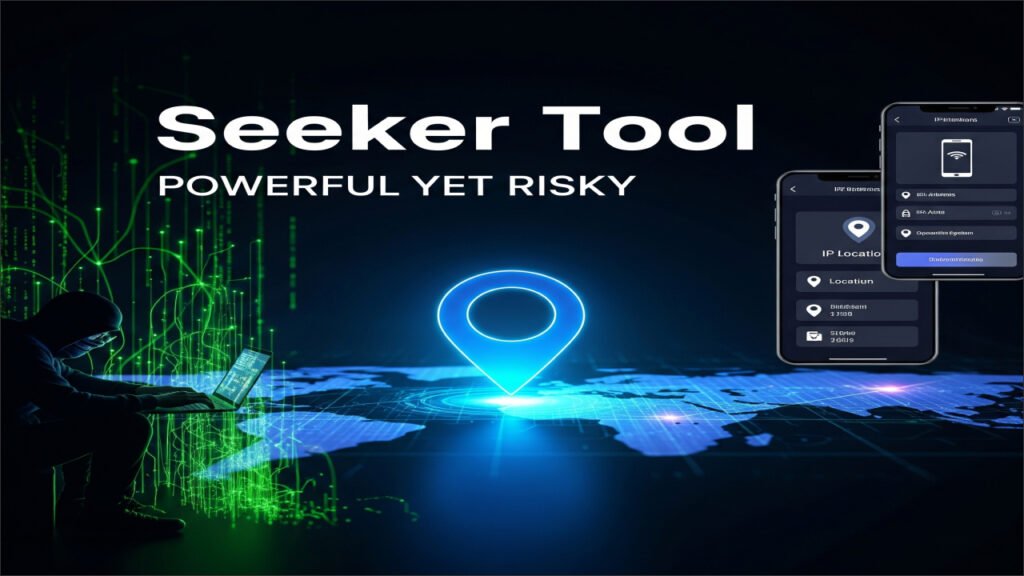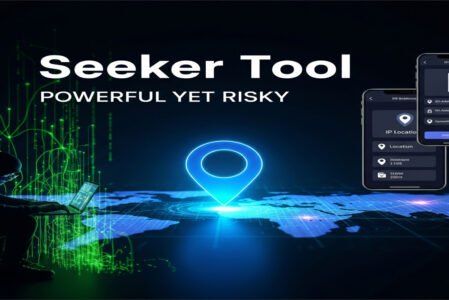Table of Contents
Introduction: Why Seeker Matters in Cybersecurity
The location data can never be more valuable than it is today. Whether it is targeted advertisements or your delivery applications, it has everything to do with knowing where you are. In cybersecurity, tracking location is not simply about being convenient, but rather about control, inquiry and even exploitation.
That’s where Seeker, a tool built for gathering precise location data through social engineering, enters the picture. It’s one of those tools that looks incredibly powerful when used responsibly—but equally dangerous if it falls into the wrong hands.
Let’s break down what makes Seeker both a favorite among ethical hackers and a nightmare when abused.

What is Seeker Tool?
At its core, Seeker is an open-source project that allows you to trick a target into sharing their exact location—without them realizing how much information they’re giving away.
Here’s the simple idea:
- You host a small webpage using Seeker.
- That page asks for the visitor’s location via their browser.
- If the victim clicks “allow” (or sometimes even without noticing), Seeker grabs their GPS coordinates.
It’s like a fishing hook for location data. That’s powerful, but you can already see why it’s controversial.
The Powerful Side of Seeker
Ethical hackers love Seeker because it’s:
- Accurate: It provides latitude and longitude with only a few meters of error.
- Practical: Perfect for pentests to prove how social engineering works in real life.
- Educational: Companies don’t believe tracking can be this easy until they see it firsthand.
When used responsibly, Seeker is a great way to raise awareness about why blindly clicking links is risky.
The Risky Side of Seeker
But here’s the catch—it’s a double-edged sword.
Cybercriminals can (and do) use Seeker for:
- Stalking or harassment
- Tracking movements of victims
- Exploiting sensitive data like home or office location
Combine Seeker with social engineering and you’ve got a weapon that could invade someone’s privacy instantly. This is why running Seeker without permission isn’t just unethical—it’s illegal.
Installation and Setup of Seeker
If you’re using Seeker for educational or ethical hacking purposes only, here’s how you can get it running on your system:
1. Clone the Repository
git clone https://github.com/thewhiteh4t/seeker.git
cd seeker2. Install Requirements
Make sure you have Python 3 installed. Then run:
pip3 install -r requirements.txt3. Install PHP
Seeker uses PHP to host the fake webpage. On Debian/Ubuntu-based systems, the installation can be done using the following command:
sudo apt install php4. Run Seeker
Start the tool using:
python3 seeker.pyIt is running in localhost by default. However, to test it on actual devices you will have to open it to the internet. This can be achieved in form of tunneling cloudflared or Serveo.
Example with Ngrok:
./cloudflared tunnel --url http://localhost:8080This generates a public link you can share with your target (during testing).
5. Get the Location Data
When someone opens the link and accepts location sharing, Seeker will show their:
- Latitude and Longitude
- Accuracy Range
- Device Information
- Google Maps link with a pin on the location
And just like that, you have the target’s live location.
Important: Use this only in legal scenarios like authorized pentests, research, or labs you control.
How Seeker Actually Works (Quick Overview)
- Hosts a fake but believable webpage.
- Sends link to the target.
- Victim’s browser requests GPS permission.
- If granted → Seeker captures exact location.
It is easy, and therefore deadly and useful at the same time.
Pros and Cons of Seeker Tool
Pros (for ethical use):
- Highly accurate GPS data
- Easy to set up
- Great for awareness training
- Lightweight and fast
Cons (risks):
- Can be abused by attackers
- Illegal without consent
- Raises serious privacy concerns
Seeker vs. Alternatives
Most location-tracking tools rely on IP addresses, which are usually off by miles. Seeker, on the other hand, uses the browser’s GPS API, making it far more precise.
Compared to spyware (which is completely malicious), Seeker sits in the “ethical hacking” category, provided you use it responsibly.
Best Practices for Ethical Hackers Using Seeker
- Always get permission first.
- Use it in demos and awareness programs.
- Educate the target after testing.
- Stay within the law.
Conclusion Tool
It seems to be such tool that forms both sides of hacking-it may be very helpful, as well as harmful. When in the possession of a responsible hacker it is an excellent means to illustrate the existence of main threats, test individuals and create the awareness. However, should it fall in any hands of interest, evidently unethical hands, then such a tool can as well be used to violate the privacy of an individual or organization.
The difference comes down to intent. If you’re on the ethical side, Seeker can be your ally in building awareness and strengthening defenses. But cross the line, and the same tool can land you in serious trouble.


